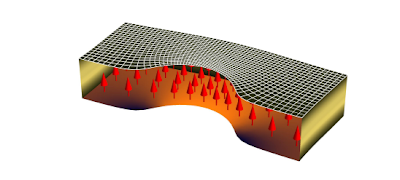IIRC, cloaking-style metamaterials have previously been used to approximate Alcubierre metrics. And if I'm remembering the Haisch-Rueda-Puthoff inertia conjecture correctly, their polarized-vacuum gravity/inertia interpretation is perfect for testing via metamaterials or related methods. - Duane
June 21, 2012
Electromagnetically Induced Invisibility Cloak Can be Switched On and Off
Arxiv - Electromagnetically induced invisibility cloaking (5 pages)
Invisibility cloaking imposes strict conditions on the refractive index pro files of cloaking media that must be satisfied to successfully hide an object. The first experimental demonstrations of cloaking used artificial metamaterials to respond to this challenge. In this work we show how a much simpler technique of electromagnetically induced transparency can be used to achieve a partial, carpet cloaking at optical frequencies in atomic vapours or solids. To generate a desired combination of low absorption with strong modifications of the refractive index, we use chiral media with an induced magneto-electrical cross-coupling. We demonstrate that high-contrast positive refractive indices can be attained by ne tuning the material with a gradient magnetic field and calculate the parameters required to construct a carpet cloak.

An incident magnetic field B is applied to control the detuning of the chiral media implemented by a magnetoelectric cross-coupling in a solid. The coupling field strength is kept at a constant value across the media. The refractive index can be tailored to achieve the needed profiles. The insert shows the actual cloaking, the curved physical space, delivering desired straight lines in virtual space.
Technology Review - Physicists have worked out how to build invisibility cloaks that hide objects with the flick of a switch
In electromagnetically induced transparency (EIT)opaque substances are made transparent by external electromagnetic fields. The fields prepare the substance in dark states that are decoupled from light of a certain frequency and polarization, thus making the material transparent for such light. EIT has been the basis for slow light in atomic vapors or solids. Here we put forward a method of electromagnetically induced cloaking where external fields manipulate the refractive index of a specially designed EIT material to guide light around an object without making the object itself transparent. Electromagnetically induced transparency and slow light have inspired applications in metamaterials; here we adopt a concept that originated in the area of metamaterials cloaking and show how it can be implemented in atomic vapors and solids.
A cloaking device consists of a transparent mantel that encloses the object to be hidden. The mantel refracts light around its hidden interior such that light exits as if it had traversed empty or uniform space, thus hiding the object and the act of hiding itself. For this, certain refractive-index pro files are required that are difficult to implement in ordinary optical materials but are (barely) feasible in metamaterials. In most cases, these should be optically anisotropic materials, but it is also possible to cloak with isotropic materials. Electromagnetically induced transparency is able to create index profiles suitable for lensing but with an index contrast that is too low for cloaking. Here we point out that another method borrowed from metamaterials research - the implementation of chiral materials- is capable of cloaking. The currently achievable index contrast is only sufficient for partial cloaking, also known as "carpet cloaking", where a curved object is made to appear at. The flattened object can then be camouflaged against the background to render it effectively invisible.
We have considered a very smooth conformal coordinate transform to implement carpet cloaking. However, such a transform limits the dimensions of the object we wish to hide. Recently, other conformal transforms have been suggested that yield larger and more irregular cloaked areas. However, these transforms have more stringent demands on the refractive index range of the cloaking media. To test whether the chiral media are suitable to perform more demanding conformal transforms we increase the cross-coupling field. We find that at higher field strengths we access larger refractive indices (n = 6:61 for detuning of = 7:935kHz). However, these require ever larger detunings which can then become unphysical. We must also limit the coupling strength of the field to avoid thermal effects. In the ranges we have plotted, the thermal effects are extremely small as the coupling fields correspond to mW laser powers.
We have presented a scheme for electromagnetically-induced invisibility using a carpet cloak. The scheme is based on coherent magneto-electric cross-coupling in a medium modeled by the 5-level atom interacting with a weak probe and the three control light fields. We obtained the steady state solutions of the corresponding Liouville equation for the density matrix elements to show that such chiral media allow for a precise control of the refractive index over a wide range, while simultaneously suppressing absorption due to quantum interference e ffects similar to EIT. We have devised the conformal transformation that is suitable for this system and found the physical parameters required to accomplish the cloaking.[/img]